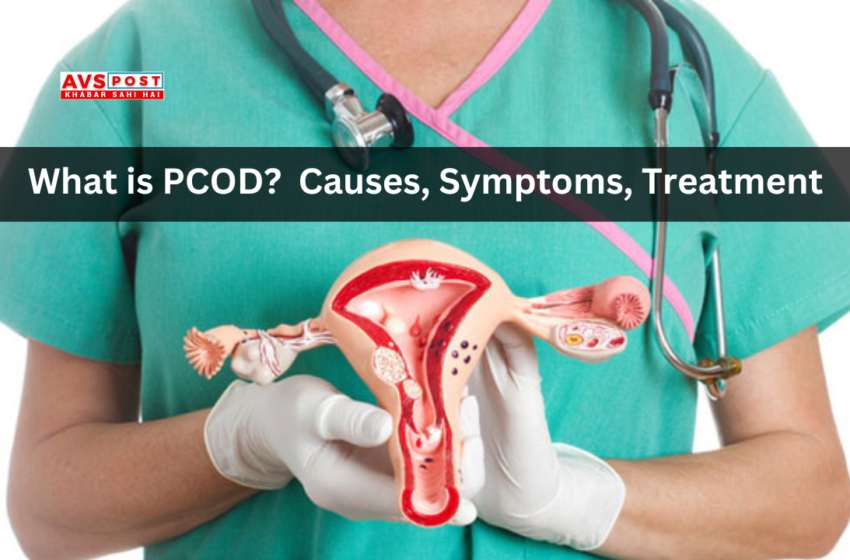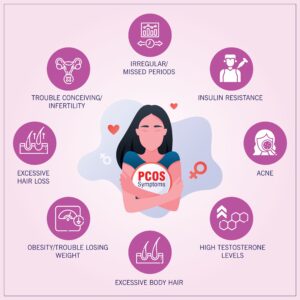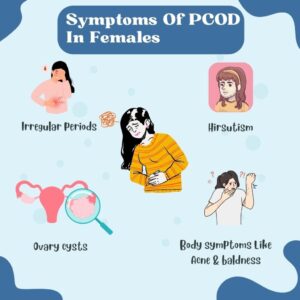Mappls : India’s Indigenous Navigation Revolution Developed by Indian Company MapmyIndia
What is PCOD? : Causes, Symptoms, Treatment. What Happens and How to Manage It.

What is PCOD?
What is PCOD?
Polycystic Ovary Syndrome (PCOS), often referred to as PCOD (Polycystic Ovary Disorder), is a common hormonal condition that affects millions of women worldwide. If you’ve heard of it but aren’t quite sure what it entails—or if you’re wondering how to avoid it—this blog is for you. Let’s dive into what PCOD is, why it happens, and practical steps to manage or even prevent its impact.
What Is PCOD?
What is PCOD? : PCOD is a condition where the ovaries produce an excess of androgens, hormones typically associated with male traits, though present in all bodies in smaller amounts. This hormonal imbalance can lead to irregular menstrual cycles, the formation of small cysts (fluid-filled sacs) on the ovaries, and a range of symptoms that vary from person to person. While the name suggests “cysts,” not every woman with PCOD has visible ovarian cysts, making it a bit of a misnomer. It’s more about the hormonal chaos than the cysts themselves.
What is PCOD? : PCOD affects roughly 1 in 10 women of reproductive age, and it’s one of the leading causes of infertility. But it’s not just about fertility it can influence your skin, weight, mood, and overall health. The good news? While it’s a chronic condition, lifestyle changes and medical support can make a huge difference.
What Happens in PCOD?
So, what’s going on inside the body when PCOD strikes? Here’s the breakdown:
- Hormonal Imbalance: The ovaries overproduce androgens (like testosterone), which disrupts the normal ovulation process. Instead of releasing an egg each month, the ovaries may hold onto immature follicles, which can turn into cysts over time.
- Irregular Periods: Without regular ovulation, menstrual cycles can become unpredictable—sometimes too frequent, too far apart, or absent altogether.
- Insulin Resistance: Many women with PCOD have trouble using insulin effectively, leading to higher blood sugar levels. This can trigger even more androgen production, creating a vicious cycle.
- Symptoms Galore: The hormonal shifts can cause acne, excessive hair growth (hirsutism) on the face or body, hair thinning on the scalp, weight gain (especially around the midsection), and even mood swings or depression.
- Long-Term Risks: If left unmanaged, PCOD increases the risk of type 2 diabetes, heart disease, and endometrial cancer due to the prolonged hormonal imbalance and insulin issues.

The exact cause of PCOD isn’t fully understood, but it’s believed to be a mix of genetics (it often runs in families) and environmental factors like diet and stress. It’s not something you “catch”—it’s more like a predisposition that gets triggered.
Symptoms of PCOD
What is PCOD? : PCOD is a hormonal condition that shows up differently in every person. While no two cases are exactly alike, there are some common signs that can hint at PCOD. Recognizing these symptoms early can help you seek support and manage the condition effectively. Here’s what to watch for:
1. Irregular Menstrual Cycles
- One of the hallmark signs of PCOD is unpredictable periods. This could mean:
- Periods that come too often (less than 21 days apart).
- Periods that are too far apart (more than 35 days) or skipped altogether.
- Heavy bleeding or very light spotting when periods do occur.
- Why? The hormonal imbalance disrupts ovulation, throwing your cycle off track.
2. Excess Hair Growth
- Notice unwanted hair sprouting on your face, chin, chest, back, or stomach? This is called hirsutism and happens because of elevated androgen (male hormone) levels.
- It’s often coarse and dark, unlike the fine “peach fuzz” most people have.
3. Acne or Oily Skin
- Stubborn acne—especially along the jawline, cheeks, or back—can pop up due to excess androgens. Your skin might also feel oilier than usual, leading to clogged pores.

4. Hair Thinning or Loss
- While hair might grow where you don’t want it, you might lose it where you do. Thinning hair or male-pattern baldness (receding hairline or widening part) on the scalp is another common symptom.
5. Weight Gain or Trouble Losing Weight
- Many women with PCOD notice unexplained weight gain, especially around the belly. Insulin resistance—a key player in PCOD—makes it harder for your body to process carbs and shed pounds.
6. Darkening of Skin
- Look out for dark, velvety patches on your skin, often around the neck, underarms, or groin. This is called acanthosis nigricans and is tied to insulin resistance.
7. Difficulty Getting Pregnant
- Irregular or absent ovulation can make it tougher to conceive. If you’ve been trying without success, PCOD might be a factor.
8. Mood Changes
- Feeling anxious, irritable, or down more than usual? Hormonal fluctuations and the stress of other symptoms can take a toll on your mental health.
9. Fatigue
- Constant tiredness or low energy can creep in, often linked to insulin issues or poor sleep (sometimes worsened by PCOD-related sleep apnea).
10. Pelvic Pain (Sometimes)
- While not as common, some women experience discomfort or pain in the pelvic area, possibly due to ovarian cysts or inflammation. However, cysts themselves don’t always cause pain.

How Does PCOD Affect Daily Life?
What is PCOD? : Imagine planning your month, only to realize your period has gone AWOL again. Or dealing with stubborn acne that won’t budge no matter what skincare you try. Maybe it’s the frustration of unwanted facial hair or the struggle to shed a few pounds despite your best efforts. For many, PCOD feels like a constant battle with their own body. Beyond the physical symptoms, it can take an emotional toll—feeling “out of control” is a common sentiment among those diagnosed.
Can You Avoid PCOD?
What is PCOD? : Since PCOD has a genetic component, you can’t entirely “prevent” it if you’re predisposed. However, you can take steps to reduce its severity, delay its onset, or manage it effectively if you’re at risk. Prevention and management go hand-in-hand, and it’s all about empowering your body to stay balanced. Let’s explore how.
How to Manage PCOD: Practical Tips
What is PCOD ? : Whether you’re trying to avoid PCOD’s effects or manage an existing diagnosis, these lifestyle tweaks can help regulate hormones, improve insulin sensitivity, and keep symptoms at bay.
1. Eat Smart, Not Less
- Focus on Low-Glycemic Foods: Foods like whole grains (quinoa, brown rice), leafy greens, berries, and lean proteins (chicken, fish, tofu) stabilize blood sugar and reduce insulin spikes.
- Cut Back on Sugar and Processed Carbs: Ditch the sodas, white bread, and pastries—they can worsen insulin resistance.
- Healthy Fats Are Your Friend: Avocados, nuts, seeds, and olive oil support hormone production without overloading your system.
- Small, Frequent Meals: Eating every 3-4 hours keeps your blood sugar steady and prevents cravings.
2. Move Your Body
- Exercise Regularly: Aim for 30 minutes most days—think brisk walking, cycling, or yoga. Strength training is especially great for boosting metabolism and tackling insulin resistance.
- Avoid Overdoing It: Extreme workouts can stress your body and increase cortisol (another hormone), so find a balance that feels good.

3. Manage Stress
- Chronic stress pumps out cortisol, which can worsen hormonal imbalances. Try mindfulness practices like meditation, deep breathing, or even a relaxing hobby (knitting, anyone?). Sleep is non-negotiable, aim for 7-9 hours to let your body reset.
4. Watch Your Weight
- Even a 5-10% reduction in body weight can restore ovulation and reduce symptoms in overweight individuals. But don’t crash diet—slow, sustainable changes are key.
5. Stay on Top of Health Checkups
- Regular visits to a doctor can catch early signs like irregular periods or insulin resistance. If you have a family history of PCOD, mention it early monitoring can make a difference.
6. Consider Supplements (With Guidance)
- Inositol: Known to improve insulin sensitivity and ovulation.
- Omega-3s: Reduces inflammation and supports hormone balance.
- Vitamin D: Many women with PCOD are deficient, and correcting it can help. Always consult a healthcare provider before starting supplements.
7. Limit Toxins
- Some research suggests endocrine-disrupting chemicals (like BPA in plastics) might worsen hormonal issues. Use glass or stainless steel for food storage and avoid heating food in plastic containers.

When to Seek Help
What is PCOD? If you notice irregular periods, sudden weight gain, excessive hair growth, or severe acne, don’t brush it off—see a healthcare professional. A simple blood test (for hormones and insulin) or an ultrasound can confirm PCOD. Treatments like birth control pills, metformin (for insulin resistance), or fertility meds can help, depending on your goals.
Also Read This : Best free AI tools for Ghibli-Style Art for Free with These AI Tools 2025
What is PCOD? : PCOD might sound overwhelming, but it doesn’t have to define you. Think of it as your body asking for a little extra TLC. With the right habits, balanced eating, movement, and stress care you can keep it in check and live your fullest life. It’s not about perfection; it’s about consistency.


